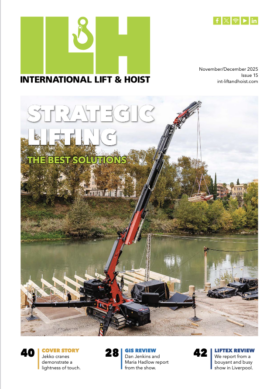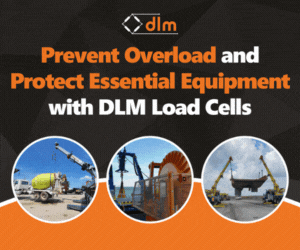)
Safety Storm
Preventing accidents where cranes are exposed to the elements, particularly wind, is an ongoing battle for multiple industries, says Joel Cox, president at Pintsch Bubenzer USA.
I wrote in this column last year about how, as machines get bigger, the more important their components and safety systems become, and I stressed the need for manufacturers to stay apace. If the latest series of outdoor crane-related accidents, notably at ports, are anything to go by, we’ve got to redouble our efforts and our attitudes towards safety.
Much of the problem stems from the fact that equipment is continuing to advance in terms of speed, height, capacity and every other area so quickly, that safety can’t always keep up. Dated equipment and operator error are issues too; snagged loads, boom failures, runaway cranes, ballast failure and vessel collisions are commonplace. All the while, Mother Nature is as cruel and brutal as she ever has been—if not more so.
The USA has a large population of cranes that are heavily influenced by wind on the coasts. The Atlantic, Pacific and Gulf Coasts are all targeted locations for storms. While the storm count is getting much higher each year and the quantity of cranes is rising, the sail area of these cranes is also getting taller and they have a larger outreach structurally. Consequential accidents are something the sector has to be acutely aware of.
Considering the going rate for a new ship-to-shore crane can be $12million+, and storm brakes account for less than 1% of the entire cost, it is frustrating that certain safety measures continue to be overlooked. In reality, owners and operators should never have to worry about high winds; storm pins and tie-downs should be fitted on all cranes regardless of location.
The steel industry, meanwhile, is increasingly acknowledging that not only are outdoor cranes impacted by wind, they also need back-up for brake, shaft or gearbox failure to maintain or keep a load safely in the air or to prevent a ladle of hot liquid falling.
The cost of an emergency brake versus the cost of a life cannot be compared. A new ladle crane might represent a $7m investment for a steel mill and we’re talking about a potentially lifesaving addition at a tiny fraction of that cost. But less than 10% of cranes in the steel sector, including new ones, are fitted with emergency brakes in the USA.
It is indicative of a much wider safety crisis.
Container journey
Not long ago, we celebrated the fact that Heerema’s Sleipnir, a giant semi-submersible crane vessel (SSCV), named after Norse god Odin’s eight-legged horse, completed a 15,300t topsides module lift. Imagine the safety engineering involved in the vessel’s components and safety systems; we installed a series of Twin Safe TS800 brakes on the 10,000t (22 million pound) capacity cranes and auxiliary hoists.
The same scalability is being seen at ports and harbours, where cranes with a typical rated lifting capacity of 65t can be 440ft tall with their booms upraised. They work with Megaships that can be up to 1300ft long and carry nearly 23,000 cargo containers. These containers are stacked up to 12 high above deck on the largest vessels, thus, taller cranes are required to reach the top of the stacks. We’re talking about operating at 174ft above dock and 225ft across deck, with some ships reaching 26 container rows.
For perspective, let’s revisit the introduction of the container to the shipping industry. The containerised concept was a giant leap forward for the sector and, as always, lifting equipment had to follow. One of the problems presented by the introduction of containers, say, in the mid-1950s was that ports were not equipped to handle the heavy loads, except by mobile-type revolving cranes and even then many lacked the required capacity. The first crane that resembled the modern day container crane was unveiled in 1959. By the end of 1980 there were around 700 ship-to-shore container handling cranes operating around the world. The capacities at the time were in the 22t region—that’s significantly less than we see today. The industry has been fast moving ever since.
Of course, safety has evolved alongside, but pressure is always intensified in the sector in the wake of an accident, which are quite common around the world, with causes ranging from hurricanes, tornados, typhoons and microbursts of wind. We have seen accidents happen not only in ports but with outdoor steel process cranes, intermodal gantries, woodyard cranes, and mining equipment—all of which could have been prevented. Unfortunately, when an incident does happen at a port, we tend to see one crane run away and take down end stops or other cranes in its path.
Inevitably, accidents in all sectors lead to injuries to people. There is some doubt as to the volume of injuries attributable to storm-related accidents but even in North America the accidents we hear about are alarming. The sector is conscious about the need to eliminate preventable incidents. Consultants help drive the industry along with mechanical engineers that specify today’s standards. We work with many of them and are fortunate that a large number are based in the USA.
Inescapably though, wind remains a constant threat. If a known storm is coming, operators should at least have storm tie downs that are mechanical and binding to the earth. The goal is to lock down cranes or, if in between stowage locations, set the storm brakes (this could be wheel, rail clamp, pushing rail clamp and / or self-blocking rail type brakes). In our findings and accident investigations, wheel chock style braking does not work as effectively, which is why we do not manufacture them.
Depending on the location of the crane and the special tie down points on a dock or runway, it might be in danger of traverse to get to those points in unexpected weather conditions. The reaction time is also very important to what operators can achieve.
During hurricane season we always raise awareness about the often overlooked issue: how do you tie your crane down? If you assume that when you see a storm coming you can grab a sling and shackle, it is too late. Having proper braking and storm brake prevention is an important consideration.
Between white papers, briefings and technological conferences, we constantly try to spread the word about accidents and, moreover, their prevention. But that work looks set to continue for the time being. Of course, cranes will continue to get bigger and heavier in capacity.
Storm brake alternative
Pintsch Bubenzer has launched a new, environmentally friendly electric wheel brake—the BRBe—for electric overhead traveling (EOT) cranes at ports, steel mills and other heavy duty applications. Installation prevents the need for runaway or storm brakes. The BRBe is designed for outdoor cranes, such as ship-to-shore, rail-mounted gantry and rubber-tired gantry cranes. In the event of microburst wind, gale storms, tornados, or hurricanes, the brake would determine the wind speed and lock; in other words, it would push down on the rail, wedge rail or grab rail head, and squeeze the wheel flanges.











